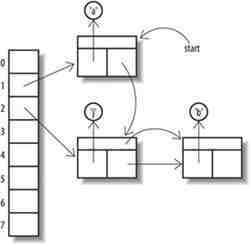Sets
A Set implements the interface
java.util.Set, it has
the same methods as those of the Collection interface.
Sets do not accept duplicate elements,
if the add() method is called with an object that already is in the
set it should return false. The elements of the set must have a good
implementation of the equals() method.
There are different implementations of
the Set interface they can have order, can be sorted, or neither
this is they can be unordered and unsorted.
HashSet
The class java.util.HashSet is
an implementation of the Set interface, it is not sorted and it
doesn't have an order. If the hashset is iterated it states that it
does not guarantee that the order will remain constant over time.
The elements of this type of set must
implement the the hashcode() and the equals() methods,
this is because it is implemented as a hash table in which
elements are stored at a position derived from their contents. So,
Two elements are considered equal or duplicate if they return the
same hash code from the hashcode() method and they return true from
testing them with the equals() method.
The Set first gets the hash code from
the element then places the element in a bucket of the hash table for
that hash code, if the bucket already has an element then it tests
for duplicity the elements with their equals().
Example:
In the previous example the Element
class has two implementations of the hashcode() method one that uses
the hashcode of its value attribute of type String and other that
generates random integers, if the implementation that uses the String
is used then the Set would not accept duplicate elements this is
because same strings should generate the same hashcode so the ouptut
with this implementation should not contain any duplicate element as
this:
[3, 2, 1, 4]
But if the implementation that
generates random integer is used then the Set would accept duplicate
elements because it would be placing each element in a different
bucket of its hash table, the output would be something like this:.
[3, 2, 1, 4, 1]
LinkedHashSet
The class java.util.LinkedHashSet
extends from the class HashSet and therefore is an implementation of
the Set interface. LinkedHashSet is hash table and a doubly-linked
list, it has an order, its iterators will return their elements in
the order in which they were added.
The LinkedHashSet doesn't define any
new method, it just adds the linked functionality to the HashSet
class.
Example:
In the previous example the output
should in the order in which the elements were added, so it should
print this:
[ 6, 5, 3, 4, 1, ]
TreeSet
The class java.util.TreeSet
is an implementation of the Set interface, it also implements the
java.util.NavigableSet and java.util.SortedSet interfaces, it is an
sorted collection and guarantees that the elements will be in
ascending order, according to their natural order, or by a Comparator
provided at set creation time, depending on which constructor is
used.
The TreeSet class implements methods
that help navigate the set, and some of these methods are:
E ceiling(e): Returns the
lowest element >= e
E higher(e): Returns the
lowest element > e
E floor(e): Returns the
highest element <= e
E lower(e): Returns the
highest element < e
E pollFirst(): Returns and
removes the first entry
E pollLast(): Returns and
removes the last entry
NavigableSet descendingSet(): Returns
a NavigableSet in reverse order
Example:
The example should print
First:1
Last:5
Higher:4
Lower:2
Ceiling:3
Floor:3
The TreeSet class also has more methods
that return section of its collection, some of this methods are:
NavigableSet headSet(e, b*):
Returns a subset ending at element e and exclusive of e
NavigableSet tailSet(e, b*):
Returns a subset starting at and inclusive of element e
NavigableSet subSet(s, b*, e, b*):
Returns a subset starting at element s and ending just before element
e
The collections that return this
methods are backed collections, this means when an element is added
to the original or to the backed collection, the new entries were
automatically added to the other collection
Example:
The example should print
Set: [a, b, c, d, g]
Sub set: [c, d]
Set: [a, b, c, d, e, g]
Sub set: [c, d, e]
Note that the subset was modified and
also the set is modified, this is because subset is a backed
collection of the set.
Go to part 5


No comments:
Post a Comment